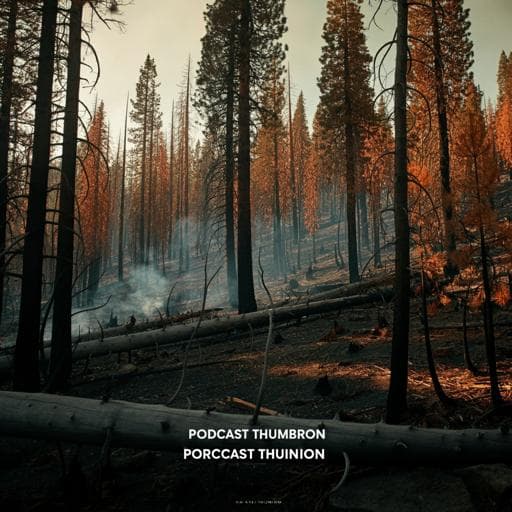
Environmental Studies and Forestry
Widespread exposure to altered fire regimes under 2°C warming is projected to transform conifer forests of the Western United States
T. J. Hoecker, S. A. Parks, et al.
Discover how changing wildfire patterns are impacting conifer forests and threatening biodiversity. This research by Tyler J. Hoecker, Sean A. Parks, Meade Krosby, and Solomon Z. Dobrowski uncovers projections of fire-regime changes across 65% of western US conifer forests and a potential decline in mean burn severity due to forest productivity and fire frequency feedbacks.
~3 min • Beginner • English
Introduction
The study addresses how climate-driven changes in fire regimes (frequency and severity) will transform conifer forests in the western United States and whether vegetation–fire feedbacks could mediate these transformations. Anthropogenic climate change, land-use legacies, and altered ignition patterns have already shifted fire dynamics, catalyzing ecological transformations when fire frequencies or intensities are misaligned with species traits or when postfire recovery is moisture-limited. While feedbacks between vegetation and fire are recognized, projecting their direction and strength and integrating fire frequency, burn severity, and ecosystem responses at broad scales remains challenging. Existing modeling approaches (correlative vs mechanistic) yield different insights and often omit dynamic vegetation–fire feedbacks or consider fire activity and postfire responses separately. This study aims to treat fire regimes and vegetation jointly as a multivariate, climate-constrained system and quantify where conifer forests will be exposed to fire-regime change under +2 °C warming, how burn severity might shift due to vegetation feedbacks, and which forests are most vulnerable given their adaptive capacity (fire-resistant traits) to persist under altered disturbance regimes. The work is intended to inform stewardship and planning as ecosystems depart from historical conditions and novel fire regimes emerge.
Literature Review
The paper synthesizes evidence showing increased wildfire activity in western North America due to climate change, suppression legacies, and human ignitions, with documented ecosystem transformations when disturbance regimes exceed species’ adaptive trait envelopes. Correlative models consistently project increases in burned area with rising fuel aridity but typically assume stationarity and underrepresent vegetation–fire feedbacks. Mechanistic models simulate dynamic ecosystem processes and can show when transformations dampen future burned area or shift severity distributions, but are computationally intensive at continental scales. Empirical work indicates vegetation feedbacks can reduce burn probability for years to decades postfire and that increased fire frequency can alter species composition, favoring fire-resistant traits in some systems while creating immaturity risk for obligate seeders in others. The authors highlight gaps: limited integration of fire occurrence, severity, and vegetation response in projections; and a need to assess vulnerability as the intersection of exposure and adaptive capacity using trait-based approaches.
Methodology
Study area: All conifer-dominated forests in the western United States where conifers comprise >50% of basal area and >5 m² ha−1, summarized within firesheds (spatial units used by US federal fire managers) containing >45 ha of conifer forest. Analyses conducted on ~0.6 km² grid cells.
Climate space and climate bins: Locations were grouped by 30-year climatological means (1961–1990) of climatic water deficit (CWD) and actual evapotranspiration (AET) derived from a monthly water balance model (TerraClimate). The AET–CWD climate space was tessellated into hexagonal bins (each ~53 mm CWD × 21 mm AET). Fire-regime attributes were characterized using observations from burned areas falling within each climate bin. Bins with <1000 burned Landsat pixels and <10 unique fire events were excluded, yielding 659 climate bins.
Data sources and preprocessing: Fire perimeters from MTBS (1984–2019). Burn severity estimated as bias-corrected Composite Burn Index (CBI) modeled in Google Earth Engine, filtering out modeled CBI <0.1. Prefire vegetation productivity quantified using Landsat NDVI in the year prior to each fire, excluding NDVI <0.35. Fire frequency quantified as fire rotation period (FRP) at a coarse grid (0.125° lon × 0.125° lat; 121–157 km²) as the proportion of forest area burned (1984–2019) divided by years observed; very low-burn bins (<0.036 proportion burned; FRP >1000 yr) were randomly assigned a proportion in [0.036, 0.720] to preserve distribution and allow inference. A random 5% sample of burned Landsat pixels was analyzed, retaining repeat-burn observations, resulting in ~7.36 million records from 4,016 fires.
Future climate scenario and analogs: A +2 °C warming scenario relative to preindustrial baselines was constructed using pattern scaling applied to observed 1986–2015 climate, based on the multi-model median of 23 CMIP5 GCMs. Projected future climate for each pixel was mapped into the AET–CWD climate space, and climate analogs were identified as contemporary bins matching the projected future climate. The future fire regime for each pixel was characterized by aggregating fire-regime observations from all analog locations corresponding to that future climate bin (space-for-time substitution, not limited by geographic distance).
Exposure metric (multivariate dissimilarity): Exposure to fire-regime change was quantified as the multivariate Earth Mover’s Distance (EMD; Wasserstein metric) between contemporary and future distributions of three attributes: FRP, CBI, and NDVI (each rescaled 0–100). Because computing multivariate EMD is expensive, the authors bootstrapped 500 samples from each regime, repeated 100 times, and used the mean EMD. Significance was assessed by comparing the bootstrapped EMD distribution for contemporary–future pairs to a null distribution derived from contemporary–contemporary comparisons; non-overlapping 95% CIs indicated significant exposure.
Mapping and summary: Exposure and attribute changes (difference in means; for CBI and NDVI presented as percent change) were mapped to all conifer forest grid cells via their climate bin. Results were summarized within firesheds as medians, with significance reported at the fireshed level based on CI overlap tests.
Adaptive capacity and vulnerability: Adaptive capacity was represented by community-weighted conifer fire-resistance trait scores (atlas integrating three morphological and three litter flammability traits) estimated from FIA plot composition. Vulnerability to transformation was defined as the intersection of high exposure and low fire resistance. Dominant forest type per fireshed was assigned using imputed FIA plot identifiers (circa 2014) and tree species group codes based on basal area proportions.
Tools: Analyses in R 4.1.1 using tidyverse, raster, terra, sf, hexbin, and emdist packages. Data and code are publicly available (Zenodo: https://zenodo.org/record/8206101; GitHub: https://github.com/tylerhoecker/future_fire).
Key Findings
- Scope of exposure: Significant multivariate dissimilarity between contemporary and +2 °C fire regimes was projected across 65% of western US conifer forests (~495,000 km²). Median dissimilarity (global) was 7.6 (IQR 4.9–11.1), vs. median null 2.2 (1.9–2.7). Median dissimilarity was significant for >95% of conifer-dominated firesheds (776/819).
- Spatial patterns of exposure: High exposure associated with steep climatic gradients and large projected AET increases (e.g., Sierra Nevada and Cascade crests, western slope of the northern Rockies), and in arid regions (southern Rockies, Southwest) driven by increasing CWD. Low exposure in coastal California and Oregon (small climate shifts) and in areas with extensive recent fire activity (southern Oregon/northern California), indicating future climates may continue to support recent elevated fire activity levels.
- Fire frequency (FRP): Study-wide median projected change in FRP was +8 years (IQR 16–33), with strong spatial heterogeneity. FRP increases (lower frequency) in central ID/MT, central CO, eastern OR/WA, and AZ; FRP decreases (higher frequency) in northwest MT, NM, and southwest CO; coastal OR/CA showed maintenance of contemporary frequencies.
- Burn severity: Future burn severity projected to be lower across 63% of conifer forests, higher for 32%, and unchanged for 5%. Declines were consistent across the northern and central Rockies.
- Productivity (NDVI): Widespread projected declines of ~0.1 NDVI units (~10%) or more, notably in eastern OR, UT, CO, NM, and AZ.
- Vegetation–fire feedbacks: Results suggest negative feedbacks may emerge under +2 °C, with ultimate reductions in burn severity in many ecosystems, potentially independent of area burned, due to interactions among productivity, fuels, and fire frequency.
- Vulnerability and forest types: High vulnerability (high exposure, low fire resistance) identified in pinyon–juniper, spruce–fir, and portions of lodgepole pine and Douglas-fir forests. Ponderosa pine forests showed high exposure but moderate to very high fire resistance. Mesic types (spruce, fir, lodgepole pine) tended toward intermediate exposure and low fire resistance, increasing vulnerability where exposure is high. Douglas-fir was widespread with a broad range of exposure and fire resistance (mean trait score ~0.49).
- Management relevance: Mapping exposure and adaptive capacity within firesheds highlights where transformation risks are greatest and where adaptation via increased abundance of fire-resistant species may facilitate forest persistence.
Discussion
The findings demonstrate that under +2 °C warming, most western US conifer forests will be exposed to altered fire regimes, with widespread projected declines in burn severity due to vegetation–fire feedbacks. By integrating fire frequency, burn severity, and productivity, the study directly addresses the research question of where fire-regime change is likely and how feedbacks may influence outcomes. The results imply that models lacking dynamic feedbacks among extent, severity, and productivity may mischaracterize future regimes and underestimate resilience in some forests.
Vulnerability depends on both exposure and adaptive capacity. Fire-resistant trait assemblages can enable adaptation to increased fire frequency if burn severity remains sufficiently low to retain seed sources and facilitate shifts in composition toward fire-adapted species. Conversely, systems with low fire resistance—at both warm-dry and cool-wet edges of forest climate space—are prone to transformation, including immaturity risk for serotinous conifers under shortened fire return intervals and regeneration limitations where repeated high-severity fire reduces seed sources and elevates microclimatic stress. The spatial heterogeneity of projected changes underscores that increases in area burned or frequency will not uniformly translate to higher severity; in many regions, negative feedbacks may lead to lower severity despite altered frequencies.
For management, the Resist–Accept–Direct (RAD) framework aligns with the mapped vulnerability: direct change where high fire resistance can be leveraged (e.g., treatments to reduce severity), accept transformation where exposure is high and resistance low, and resist in selected places through suppression or reforestation to maintain specific values. These insights support proactive, place-based stewardship planning under realistic future fire regimes.
Conclusion
This study provides a multivariate, trait-informed projection of future fire regimes in western US conifer forests under +2 °C warming, showing that 65% of forest area will be exposed to significant regime change, with burn severity likely to decline across most areas due to vegetation–fire feedbacks. By intersecting exposure with community-weighted fire-resistance traits, the work identifies where adaptation via compositional shifts may sustain forests and where vulnerability to transformation is highest (e.g., pinyon–juniper, spruce–fir, parts of lodgepole pine and Douglas-fir). The results offer actionable, fireshed-level information to guide stewardship decisions within the RAD framework.
Future research should refine transient dynamics and timing of shifts, incorporate extreme fire weather and ignition patterns, better represent short-interval effects and seed-source limitations, evaluate interactions with competing vegetation, and expand to consider transitions to non-conifer communities. Integrating dynamic vegetation and feedbacks into regional projections will improve risk assessments and inform targeted adaptation strategies.
Limitations
- Analog constraints and stationarity in climate space: The approach cannot extrapolate beyond empirically observed climate–fire regime combinations; future regimes are limited to contemporary observations within the AET–CWD space and assume quasi-equilibrium vegetation–climate relationships over short timescales.
- Temporal abstraction: Comparisons are between a single contemporary and a single +2 °C future condition; the method does not resolve the timing or transient pathways of change.
- Extreme events: Potential impacts of extreme fire weather and abrupt regime shifts may be underrepresented.
- Management legacies and ignitions: Effects of fire suppression and other legacies cannot be removed; ignitions are not explicitly modeled (though not currently limiting regionally), which may affect spatial and temporal fire patterns.
- Short-interval fires and immaturity risk: Consequences of unusually short fire return intervals, seed-source loss, and microclimatic feedbacks on regeneration are not explicitly modeled, potentially underestimating transformation risk in some systems.
- Trait scope: Adaptive capacity is limited to conifer fire-resistance traits and does not consider shifts to broadleaf-dominated systems, which can exhibit different resilience mechanisms.
- Statistical support variability: Although minimum criteria were imposed, some climate bins have differing sample depths; the FRP adjustment for very rare fire introduces uncertainty at the dry extremes.
Related Publications
Explore these studies to deepen your understanding of the subject.







